Introduction
In today's fast-paced digital landscape, organizations are increasingly embracing DevOps as a transformative approach to software development and delivery. DevOps combines automation, collaboration, and continuous improvement to accelerate time-to-market, enhance product quality, and amplify customer satisfaction. But how can organizations successfully navigate this complex journey?
This article provides a comprehensive guide to implementing DevOps, from assessing the current state and formulating a strategy to establishing a CI/CD foundation, modernizing infrastructure with Infrastructure as Code (IaC), optimizing feedback loops, evolving culture and organization, selecting and integrating tools, investing in training and development, piloting and scaling DevOps practices, defining key performance indicators (KPIs), and embracing iterative improvement and continuous monitoring. With a focus on industry trends and real-world examples, this article equips organizations with the knowledge and strategies needed to embark on a successful DevOps transformation.
Step 1: Assess the Current State and Define Objectives
Starting a transformation in software development and delivery frameworks requires a thorough evaluation of your current methodologies. Scrutinizing these processes to spot bottlenecks, inefficiencies, and areas ripe for enhancement is critical. For instance, TBC Bank, a premier financial entity in Georgia, embraced this approach by aligning its digital strategy with its mission to simplify people's lives. The bank focused on accelerating time-to-market for its digital offerings, thus enhancing customer and employee experiences across its branches.
While identifying improvement opportunities, it's crucial to establish clear objectives for your journey towards improved operations. Objectives may range from boosting market responsiveness to elevating product quality or augmenting customer satisfaction. This clear strategy allows for a tailored roadmap that effectively caters to the distinctive requirements of your company. Taking cues from industry movements, such as LinkedIn's transition to Azure Linux, illustrates the significance of a tailored strategy that accounts for an organization's specific operational ecosystem and aspirations.
Statistics underscore the importance of this meticulous planning; a mere 19% of developers report satisfaction with their current roles, a reflection of the prevailing need to advance code quality and developer environments. While you chart your course for adopting the methodology, remember that the journey is as unique as your business, with no one-size-fits-all solution. By adhering to this individualized, goal-oriented approach, you're better positioned to deliver continuous value and maintain a competitive edge in the fast-evolving digital landscape.
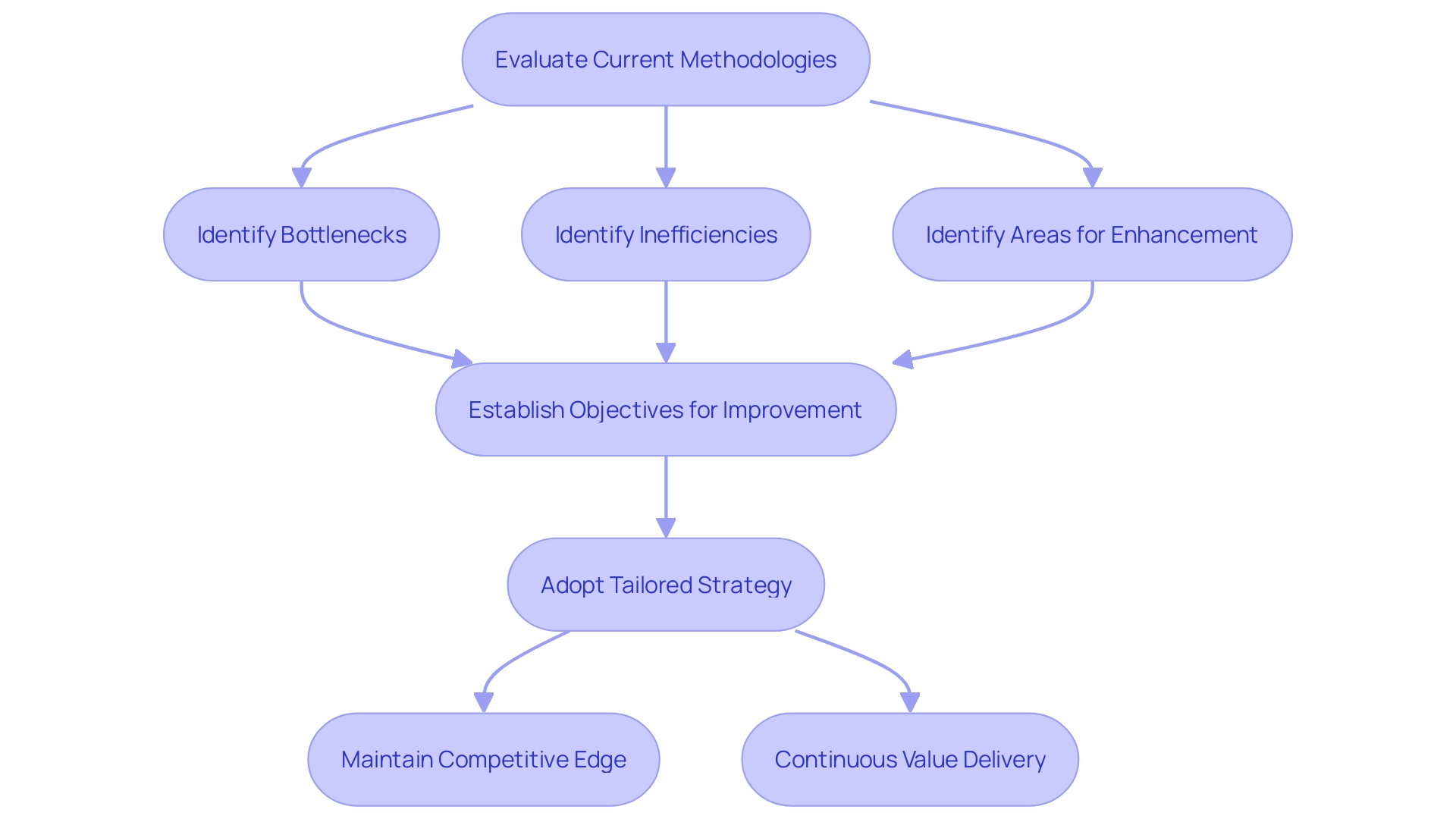
Step 2: Formulate a DevOps Strategy
To guarantee the triumph of a transformation in software development and operations, it's crucial to carefully design a plan that encompasses the core principles and practices of modern software delivery. Core to this methodology is the adoption of automation, continuous integration, continuous delivery, and fostering an environment of collaboration. These practices are not just operational shifts but represent a deep cultural change that aligns with and propels the business's objectives forward.
A prime example of strategic implementation is the introduction of a tailored workflow referred to as 'GitFeatureFlow.' This approach, while influenced by existing workflows such as Git-Flow, GitHub Flow, and GitLab Flow, has been adapted to meet the specific needs of a project's team size and dynamics. It highlights the significance of reflecting updates on a testing server in real-time through automatic uploads via continuous integration (CI), demonstrating the flexibility and responsiveness of a well-architected software development strategy.
The decision to embrace modern software development practices must start with a clear 'why' before addressing the 'how' For instance, when considering a transition to microservices, the objective should focus on enabling small teams to independently develop and manage services with minimal impact on adjacent services. This strategic approach allows for selective migration and new service development in line with the modern microservices architecture, while maintaining stability within existing monolithic systems.
Furthermore, the incorporation of artificial intelligence (AI) into software development and operations is quickly progressing, with AI algorithms now able to provide customers with personalized, real-time content according to their preferences and behaviors. This integration is a testament to the capability of technology and tailored experiences to enhance customer engagement.
Furthermore, the division of responsibilities, a concept being promoted in the infrastructure domain, aligns with principles of collaborative development and operations by enabling developers to define resource requirements while enabling operators to decide how those resources are allocated. Such methodologies promote a multi-cloud approach, further emphasizing the adaptability and resourcefulness of a solid software development and operations strategy.
An IT operations and development strategy must also consider the granularity of authentication protocols and policies, ensuring they are adequately addressed. For example, the creative method of analyzing authentication requests through platforms like Silverfort to determine the need for multi-factor authentication (MFA) reflects the security-focused aspect of the development and operations approach.
As a comprehensive and transformative methodology, DevOps has emerged as a significant shift in software creation, focusing on continuous improvement. The adoption of automation tools designed to streamline the software development lifecycle (SDLC) is crucial in bridging the gap between development, operations, and quality assurance. Automating processes such as CI, continuous delivery (CD), infrastructure as code (IAC), configuration management, monitoring, and logging not only reduces overhead but also accelerates time to market, aligning with the strategic business goals of predictability, efficiency, and sustainability.
In summary, a strong operations and development strategy is multi-faceted, encompassing automation, cultural change, strategic planning, and the integration of advanced technologies like AI. By articulating a clear roadmap for implementation, organizations can navigate the complexities of transformation and position themselves for success in the evolving technological landscape.
Step 3: Establish a CI/CD Foundation
DevOps strategies are critically important in the banking sector, where digital transformation is driven by consumer habits, competitive pressures, and technological advancements. For example, TBC Bank, with its mission to facilitate banking services, has sought to improve its time-to-market for digital products, reflecting a broader industry trend of adopting new technologies to meet rigorous security and regulatory demands. Likewise, M&T Bank's implementation of company-wide Clean Code guidelines demonstrates the industry's commitment to the maintainability and performance of applications in a sector that cannot tolerate the negative impact of program problems.
To enhance these efforts, Continuous Integration and Continuous Delivery (CI/CD) systems are essential. An effective CI/CD pipeline integrates version control, automates tests, and streamlines deployments, thus reducing the risk of introducing vulnerabilities into production as evidenced by Lendlease's strategic integration of legacy code. By automating these processes, organizations can achieve faster, more reliable releases, and maintain high-quality standards compliant with industry regulations.
Furthermore, as the DevOps ecosystem evolves, the 'You Build It, You Run It' approach has been questioned. The notion that developers should be solely responsible for both creating and maintaining code in production is debunked by Natan Yellin, highlighting the importance of a cultural shift towards shared responsibility and collaborative problem-solving in engineering and operations.
The urgency of adopting CI/CD is further underscored by statistics. With less than 1% of the global labor pool being developers, the demand to 'do more with less' and improve team performance is more pressing than ever. Integrating a CI/CD pipeline can help organizations make the most of this scarce resource by enabling more efficient development cycles.
To stay competitive and meet the highest standards of software quality and compliance, financial institutions must keep evolving their development and operations strategies, leveraging continuous integration and continuous delivery pipelines to enhance efficiency and reliability in delivering software to their customers.
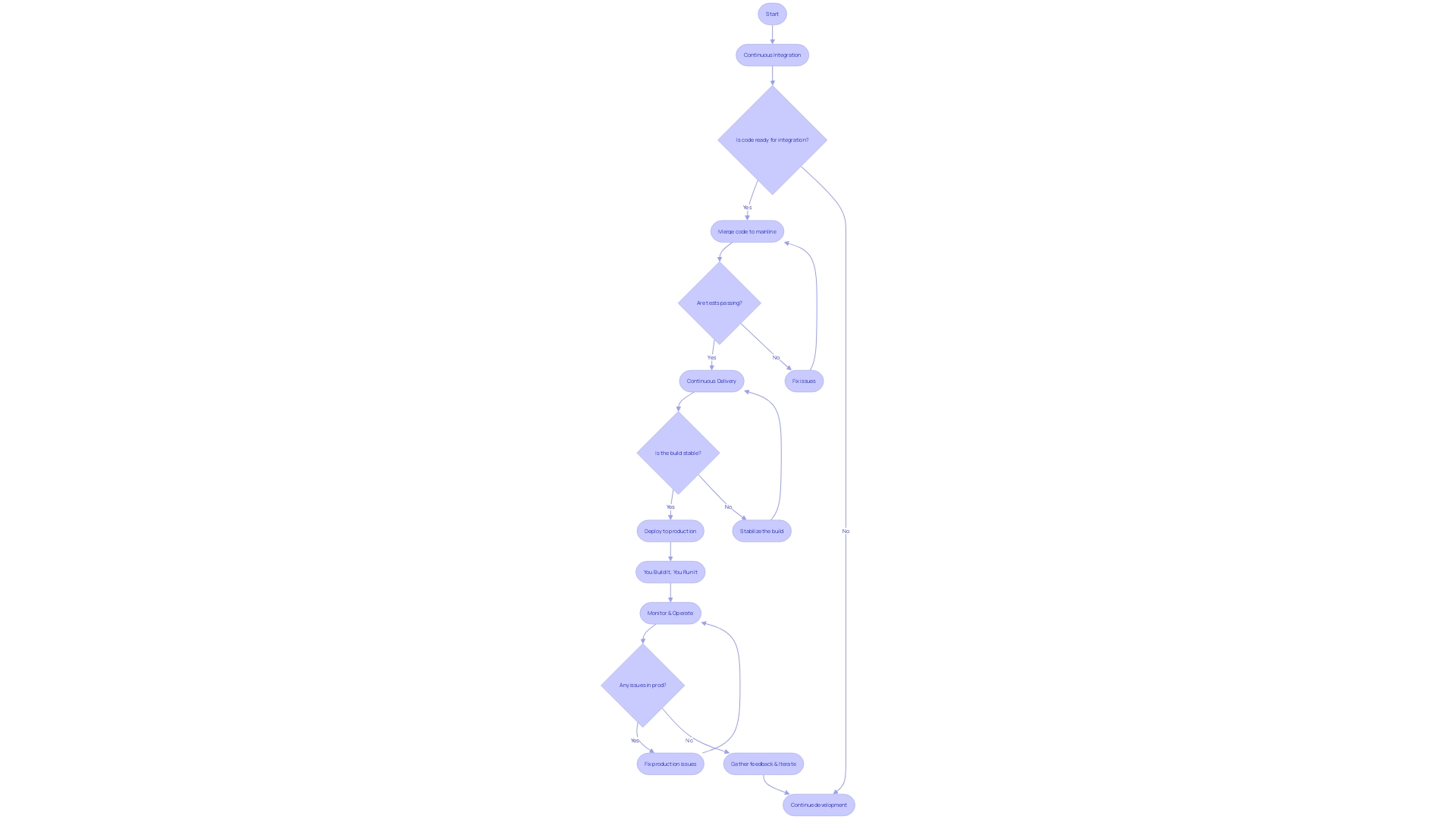
Step 4: Modernize Infrastructure with Infrastructure as Code (IaC)
The adoption of Infrastructure as Code (IAC) is a transformative movement within the realm of DevOps, revolutionizing how we manage and provision our technical resources. The essence of IAC lies in its capacity to encode infrastructure, enabling the consistent deployment of environments through machine-readable definitions. This approach not only enhances scalability and agility but also significantly diminishes the likelihood of human-induced discrepancies.
With IaC, the entirety of a company's infrastructure—spanning servers, networks, and databases—can be orchestrated through code. This automation transcends the conventional methods of setup and configuration, ushering in a new era of precision and repeatability. Embracing tools such as configuration management and infrastructure automation, businesses can expedite provisioning while fostering robust collaboration between developers and operators.
To illustrate the profound impact of IAC, we can draw parallels to the construction of the Hoover Dam—an exemplar of engineering innovation and project execution. Despite the challenges of its time, the dam's successful completion ahead of schedule epitomizes the potential of well-managed, large-scale projects. Similarly, IAC allows companies to address ambitious technological endeavors with confidence, reflecting the thorough planning and execution of historical engineering feats.
In light of the rapid evolution of the digital landscape, where agility and speed are paramount, IAC stands out as a cornerstone for tech firms seeking to maintain a competitive edge. By incorporating Infrastructure as Code (IAC) into their workflows, companies are not just speeding up their product creation processes using approaches such as agile and minimum viable product, but they are also establishing a robust basis for ongoing innovation.
As businesses continue to navigate the interconnected realms of blockchain technology, sustainability, and artificial intelligence, the role of IAC becomes increasingly critical. It is the bedrock upon which enterprises can build and evolve their systems, much in the way the Internet Computer has demonstrated through its emphasis on smart contracts for enterprise solutions. The combination of IAC and emerging technologies is crucial for the strategic success of any entity that prioritizes software in its operations and customer experiences.
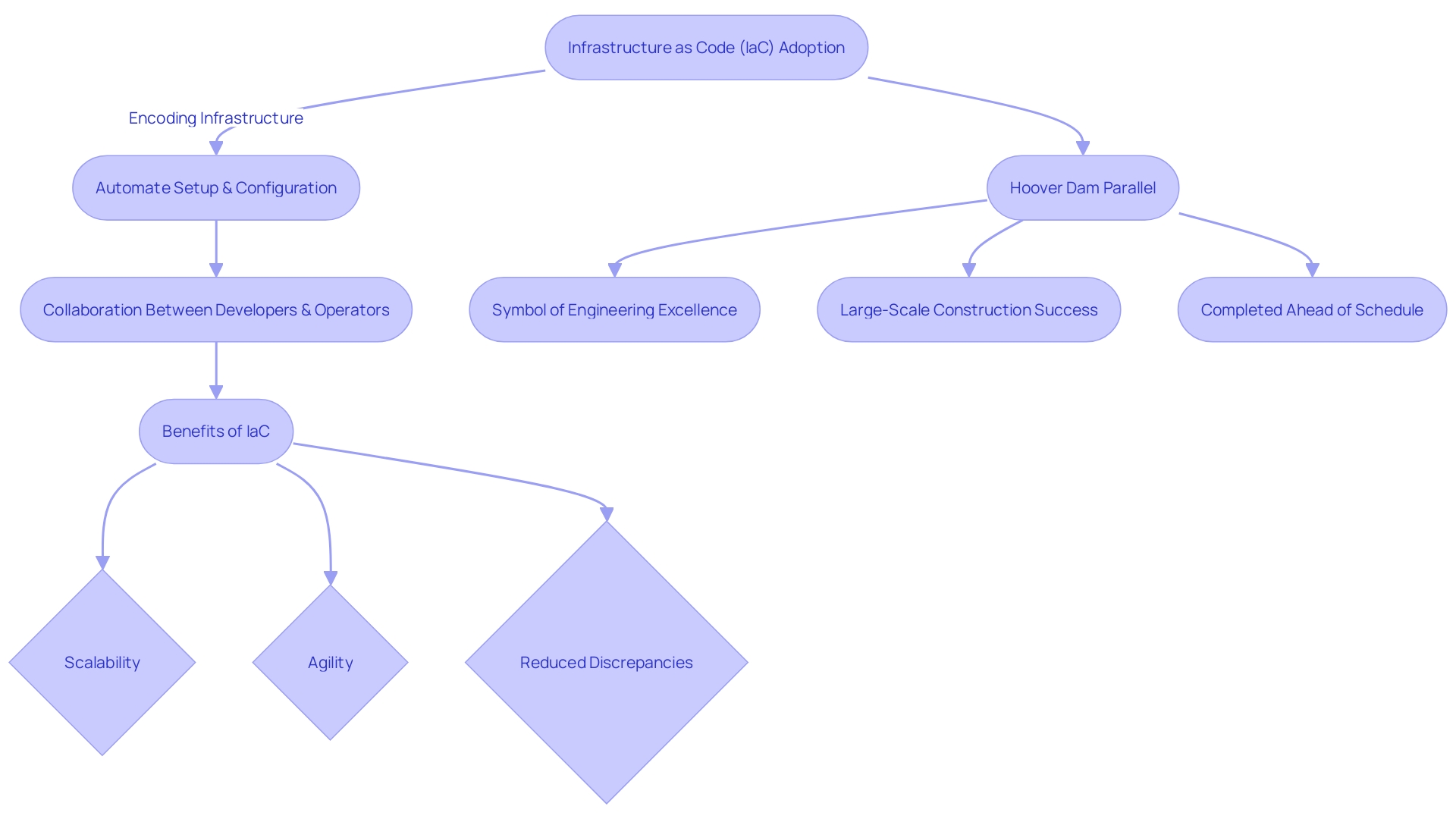
Step 5: Optimize Feedback Loops
In the dynamic landscape of software delivery, a strong DevOps strategy is vital for streamlining development and operations to deliver high-quality applications swiftly and efficiently. Crucial to this strategy are feedback loops that strengthen the collaboration among customers, developers, and operations teams. These loops are not merely channels for communication; they are sophisticated means to capture, analyze, and leverage feedback to pinpoint areas ripe for enhancement. By incorporating methods like thorough tracking, detailed recording, and extensive analysis, entities acquire valuable understandings into their software's performance and quality. The transformative impact of these practices is clear at TBC Bank, where a dedication to enhancing digital product time-to-market has been paramount, and at Bosch, where the pursuit of sustainable energy solutions has been accelerated by leveraging feedback to refine engineering processes. The continuous refinement of feedback loops is a testament to an organization's commitment to perpetual improvement, ensuring that customer value is not just delivered but consistently amplified.

Step 6: Evolve Culture and Organization
A transformation that focuses on the integration of development and operations transcends mere tool adoption or process refinement; it necessitates a paradigm shift in both culture and organizational structure. This evolution demands nurturing a collaborative ethos, establishing trust, and encouraging perpetual learning. Connecting the divide between growth and operations is essential, as it promotes cross-functional teamwork. Furthermore, fostering employees through training and skill development is essential for their proficiency in a software development environment. Such cultural and organizational advancements establish the foundation for a sustainable transformation, ultimately enhancing operational predictability, efficiency, security, and sustainability, as underscored by the methodology.
For instance, TBC Bank in Georgia recognized the importance of enhancing their digital product delivery to streamline customer experiences. Likewise, a prominent merchant in Chile struggled with talent retention and recruitment during fast organizational expansion, emphasizing the requirement for an approach that promotes a better employee journey. These cases illustrate the imperative for continuous improvement and adaptation to maintain competitiveness and operational efficacy in today's dynamic market. Furthermore, statistics indicate that businesses must periodically adapt to survive, with technology advancements being a principal change driver. The Developer Experience Lab's insights reveal that improving the developer experience is key to achieving productivity in a sustainable manner, shifting focus from simply increasing output to enhancing the work environment.
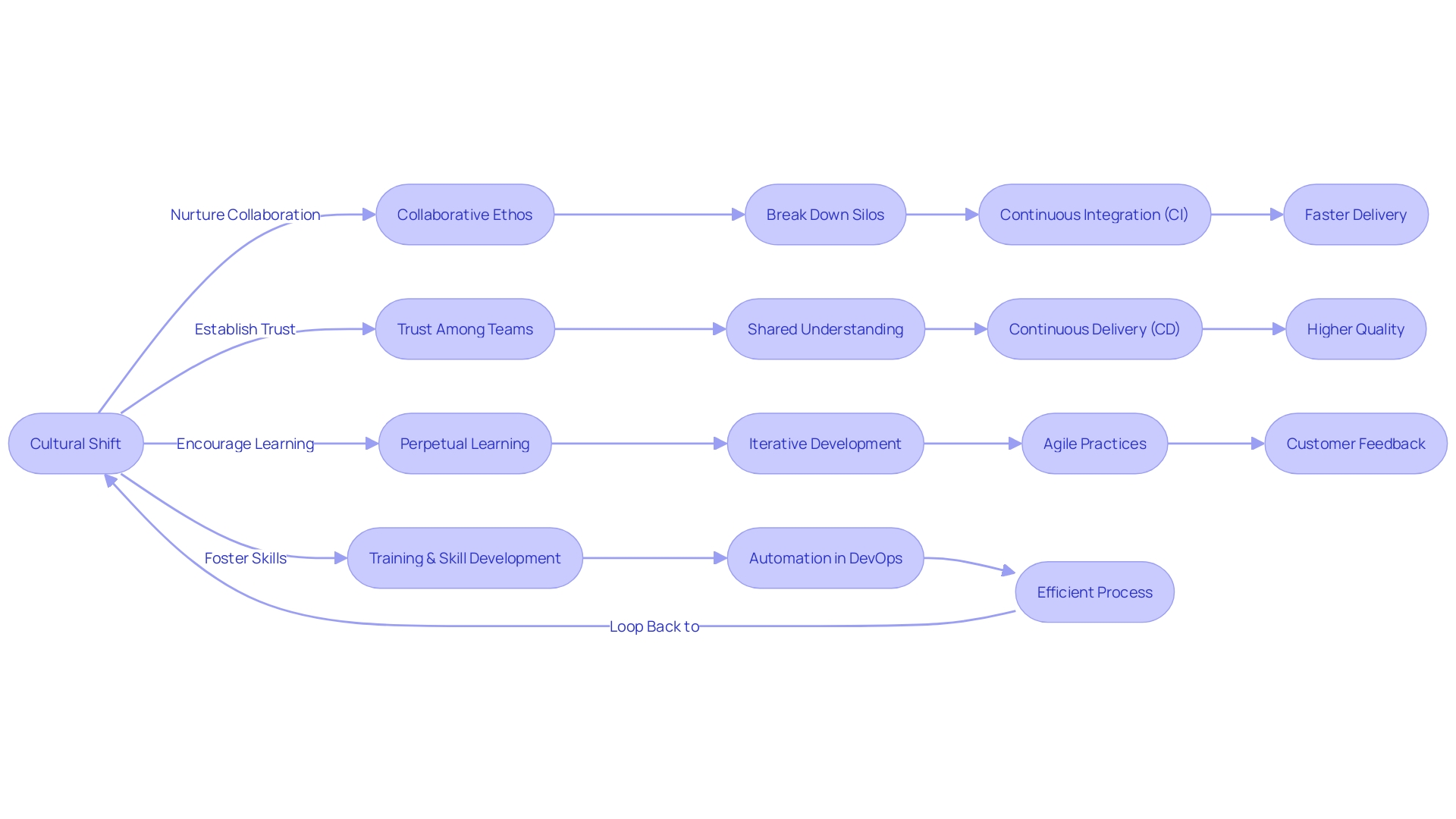
Key DevOps Trends for 2024
In the ever-changing environment of modern software development practices, staying up to date with the most recent trends is not only advantageous but also crucial for companies striving to improve their operational effectiveness and competitive edge. As we journey through 2024, several trends are shaping the field:
- AI and Machine Learning in DevOps: The fusion of artificial intelligence and machine learning with DevOps is revolutionizing how we automate and refine the DevOps lifecycle. This integration is not just an improvement; it's a transformative force that is reshaping the landscape of software creation and operations, allowing for unprecedented levels of automation and optimization.
DevSecOps, the merging of security and operations, symbolizes a fundamental change in our approach to creating and maintaining applications. It's no longer sufficient to tack on security as an afterthought. DevSecOps embeds security protocols and tools right from the outset, which is instrumental in building robust, secure applications from the ground up.
-
Serverless Computing: Embracing serverless architectures is more than a trend—it's a strategic move towards greater scalability and reduced infrastructure overhead. Developers can thereby concentrate on their core competency: coding, while the cloud provider manages the servers.
-
Kubernetes and Containerization: Kubernetes and other container technologies are gaining traction, streamlining the deployment process. By encapsulating applications in containers, developers can ensure consistency across environments, leading to more efficient and reliable deployments.
These trends are not just theoretical; they are based on practical advancements in the industry. For instance, a study involving more than 1,300 developers highlighted the growing adoption of containerization, with 42% of respondents from small companies acknowledging its impact on their workflow.
Moreover, the rise of platform engineering underscores the necessity of automating the entire software delivery process. As we've seen, this is not just a trend driven by preference but by the need to manage increasingly complex distributed systems.
Moreover, the implementation of AI is not restricted to automation; it is also driving innovation across various business areas, from marketing to product growth. A focus on generative AI has seen the highest adoption in marketing and sales, illustrating its transformative potential.
As these trends continue to evolve, staying updated and integrating them into your development and operations strategy is not an option but a requirement to future-proof your business. It's not just about keeping pace; it's about leveraging these advancements to drive innovation and maintain a competitive edge in a rapidly changing technological landscape.
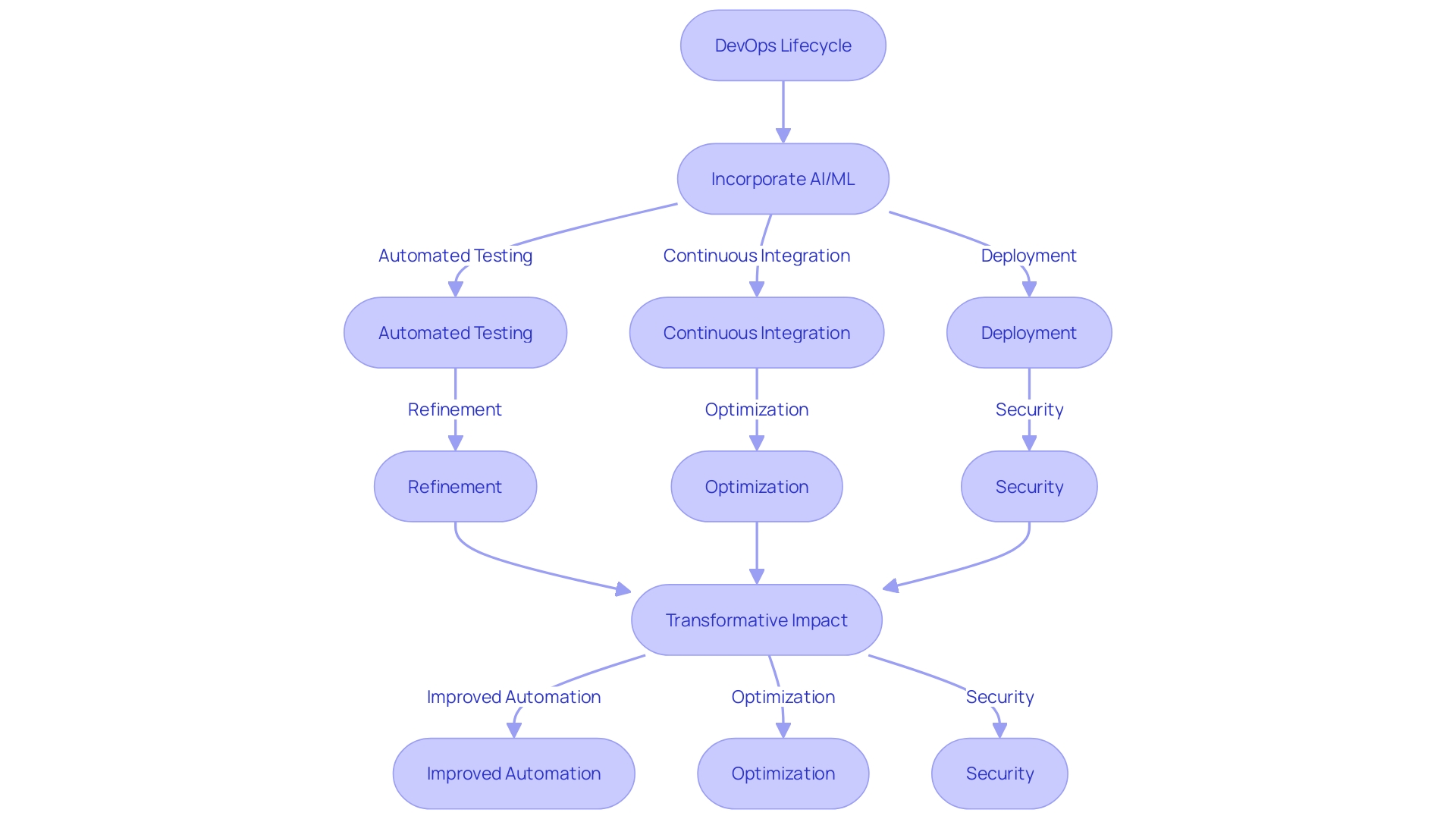
Implementing Core DevOps Principles
Embracing fundamental principles is essential for orchestrating a successful transformation in software development practices. Automation stands as a critical principle, streamlining repetitive tasks to enhance efficiency and minimize errors. For instance, automating build, test, and deployment workflows can significantly boost productivity. Continuous Integration (CI) is another cornerstone, promoting the merging of code from multiple developers into a single repository frequently, thus reducing integration conflicts and enabling more consistent testing.
Continuous Delivery (CD) ensures that code changes are deployment-ready, fostering a reliable and swift transition to production. This involves setting up a robust CI/CD pipeline that incorporates automated testing, deployment, and monitoring to maintain a steady flow of updates. Collaboration is the linchpin of the practice, dismantling barriers between teams and nurturing an environment where cross-functional groups can thrive through open communication channels and shared tools.
The application of these principles establishes the foundation for a resilient culture. For instance, a new workflow dubbed 'GitFeatureFlow' has been adopted by some, which emphasizes simplicity and reflects content on a testing server through automatic updates via CI. This is just one example of how workflows can be adapted to suit project needs, underscoring the adaptability at the heart of the development operations.
Safety is also a fundamental aspect of DevSecOps, and demands a cooperative, security-first mentality across all areas of an enterprise. The adoption of DevSecOps practices is crucial in today's landscape of sophisticated cyber threats, ensuring that security is woven throughout the application development lifecycle without hindering the velocity of operational processes or the developer experience.
By incorporating these principles, a company can anticipate a favorable change in its development lifecycle, characterized by improved predictability, efficiency, security, and alignment with business goals. The change brought about by the integration of development and operations is reflective of a broader movement in software engineering that values continuous improvement, automation, and collaboration for the delivery of high-quality software.
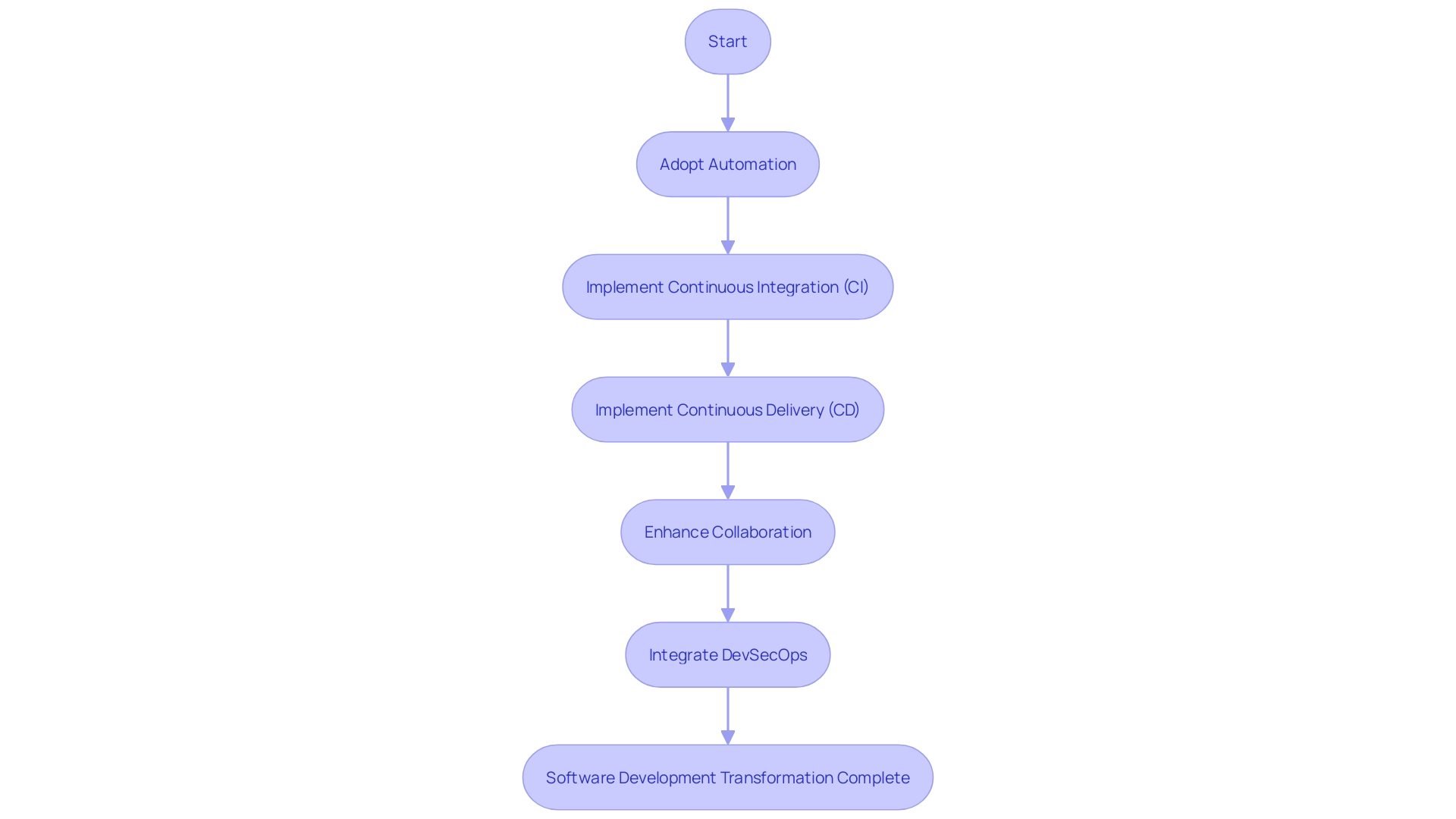
Selecting and Integrating Tools
Having the correct collection of tools is crucial for a prosperous transformation in software development and operations, allowing companies to enhance procedures and boost effectiveness. To select and integrate these tools effectively, here's a strategic approach:
-
Identify Needs: Begin by evaluating your organization's specific needs, focusing on scalability, integration capabilities, and user-friendliness. For instance, TBC Bank's mission to accelerate the time-to-market for its digital products necessitated a selection of tools that supported rapid deployment and ease of use.
-
Research and Evaluate: Investigate the available tools, assessing them against your criteria. Considerations should include the tool's features, the support provided by its community, and the reputation of the vendor. A comprehensive resource like the 'Periodic Table of Tools for DevOps' can be instrumental in categorizing and comparing the tools needed for various functions within the DevOps ecosystem.
-
Pilot and Test: Implement the tool in a controlled setting to evaluate its performance. This step should involve key stakeholders to ensure the tool meets the practical needs of your team. Companies like Bosch have successfully applied this approach, building lean and efficient data platforms for sustainable energy solutions.
-
Integration: After selecting the appropriate tools, integrate them within your existing workflow, ensuring compatibility and functionality. The integration should promote a seamless workflow and support the overall strategy of continuous integration, delivery, and deployment. This integration is exemplified in the pipelines used by many organizations, where tools are streamlined to automate from code writing to production deployment.
By systematically following these steps, you will align your tool selection with your overarching goals, thus fostering an environment conducive to continuous improvement and efficient delivery.
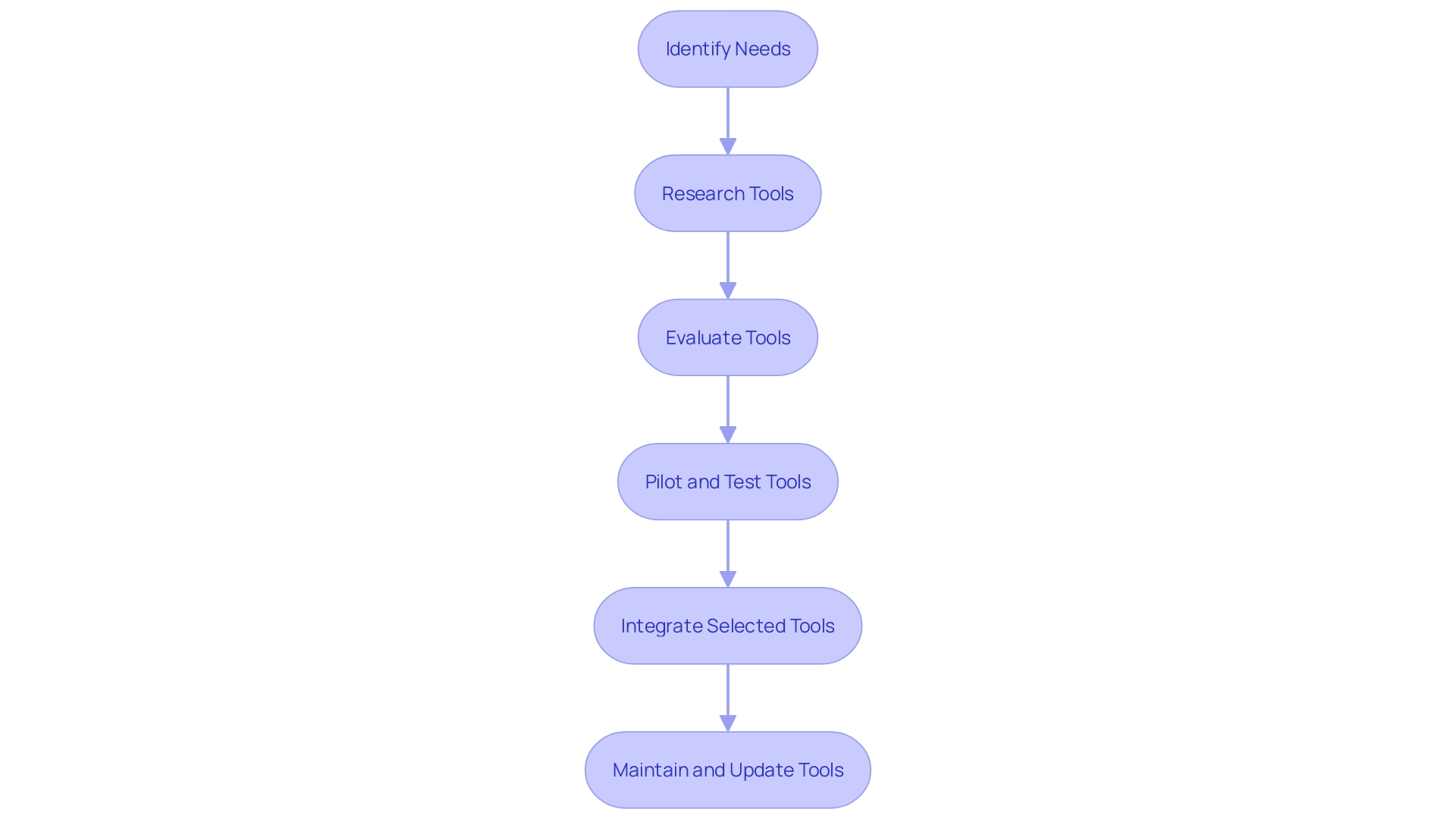
Investing in Training and Development
To achieve a successful transformation in software development and operations, it's crucial to invest in the training and development of your team. Understanding and addressing skill gaps is the first step towards ensuring your workforce is equipped to meet the demands of an evolving technological landscape. An effective strategy involves assessing your team's current abilities and identifying areas that require enhancement. Once these gaps are recognized, providing tailored training opportunities becomes pivotal. This could include workshops, certification programs, and fostering a climate of continuous learning and self-improvement.
Fostering a learning culture within your company is equally important, encouraging team members to exchange knowledge and experiences. Such a setting not only uplifts individual team members but also collectively enhances the expertise in modern software development practices.
Moreover, supporting career growth is essential to maintain an engaged and motivated workforce. Promoting clear career paths and mentoring programs can assist individuals in envisioning a future within the company, aligning their personal growth with the company's objectives in implementing development and operations (DevOps) methodology.
Statistics from the 2023 Lean into Learning report emphasize the importance of skilling in the current year and highlight strategies for holistic workforce transformation. This emphasizes the need for investing in training for the adoption and mastery of modern software development practices.
Case studies from companies like TBC Bank and a leading retail organization in Chile demonstrate the real-world impact of these strategies. TBC Bank's goal to enhance time-to-market for digital products and the retailer's dedication to becoming a favored workplace for technologists demonstrate the concrete advantages of investing in learning and growth as part of their technology journey.
In the news, initiatives like Microsoft's Radius project aim to simplify cloud application complexity by enabling developers to specify resource needs while allowing operators to determine resource provisioning. This demonstrates the broader industry movement towards promoting improved cooperation between operations and engineering groups - a fundamental principle of the software building process.
Finally, statements from industry professionals strengthen the core of the collaboration between teams responsible for the creation and operation processes, which aims to enhance efficiency and teamwork. This collection of methodologies and cultural beliefs is intended to automate and streamline the software creation lifecycle, promoting a culture of continuous integration and continuous delivery.
By investing in the ongoing growth of your team, you establish a strong basis for a transformation that is long-lasting, effective, and in harmony with the strategic objectives of your company.

Piloting and Scaling DevOps Practices
Transformation is a strategic imperative that goes beyond mere technical changes; it encapsulates a cultural shift and requires a thorough approach to implementation. To begin this change, companies start by identifying pilot projects that are emblematic of the broader objectives they wish to achieve. These projects should not only have clear goals but also offer measurable outcomes, serving as a blueprint for subsequent initiatives. By choosing a well-rounded combination of projects, companies can experiment with operational development practices in various settings and gain insightful knowledge that assists in broader implementation.
Once pilot projects are underway, it is essential to establish key performance indicators (KPIs) that reflect the organization's priorities. Metrics such as time-to-market, defect rates, and customer satisfaction are crucial in assessing the effectiveness of software development and operations practices. For example, Continuous Integration (CI) practices, where developers frequently merge code changes into a central repository, can significantly reduce integration conflicts and enable quicker feedback loops.
Monitoring and evaluating these KPIs should be an ongoing process, allowing for real-time adjustments based on stakeholder feedback. A case in point is Tabcorp, Australia's largest wagering and gaming company, which faced a complex web of development and deployment challenges. By adopting the principles of continuous integration and employing tools like Ansible for automation, Tabcorp was able to streamline their processes, despite the inherent challenges that come with automation tools.
After a pilot project proves successful, the next move is to expand these practices throughout the company. This involves sharing knowledge, best practices, and lessons learned with other teams. An organization that exemplifies this is a global group comprising over 10 brands with a workforce of 1,000+ employees, which has successfully integrated development and operations practices into its culture, thereby enhancing collaboration and driving continuous transformation as a competitive advantage.
In essence, piloting and scaling the practice of modern software development is not a linear path but a cyclical process of continuous improvement. The goal is not just to automate tasks but to foster a culture of collaboration, increase the speed of development and delivery, and enhance the quality of software products. By adhering to these structured steps, companies can effectively navigate the complexities of adopting and harnessing the full potential of DevOps for strategic business transformation.
Defining Key Performance Indicators (KPIs)
Crafting effective key performance indicators (KPIs) is a crucial aspect of gauging the efficacy and impact of your initiatives. To establish these benchmarks:
-
Alignment with Business Objectives: The KPIs should be in sync with your organization's overarching goals. Reflect on aspects such as accelerated time-to-market, elevated product quality, and heightened customer satisfaction which directly influence your business performance.
-
Selection of Metrics: Pinpoint specific metrics that will serve as a compass to your business objectives. Metrics like deployment frequency, lead time for changes, and mean time to recovery (MTTR) are crucial in tracking your progress and guiding your operational strategies.
-
Baseline Establishment: To effectively monitor advancement, it's imperative to set initial baselines for your KPIs. This enables you to identify areas in need of improvement and to measure the advantages brought about by your practices.
-
Ongoing Monitoring and Assessment: Keep a vigilant eye on your KPIs and conduct regular reviews to ascertain if your transformation is progressing as planned. Adapt and recalibrate strategies to align with your organizational targets.
Through the meticulous definition and management of KPIs, your organization can navigate the complex digital landscape with confidence, ensuring that technology investments yield desired outcomes and propel the business forward. With this approach, decisions become more data-centric, enabling continuous enhancement and innovation.
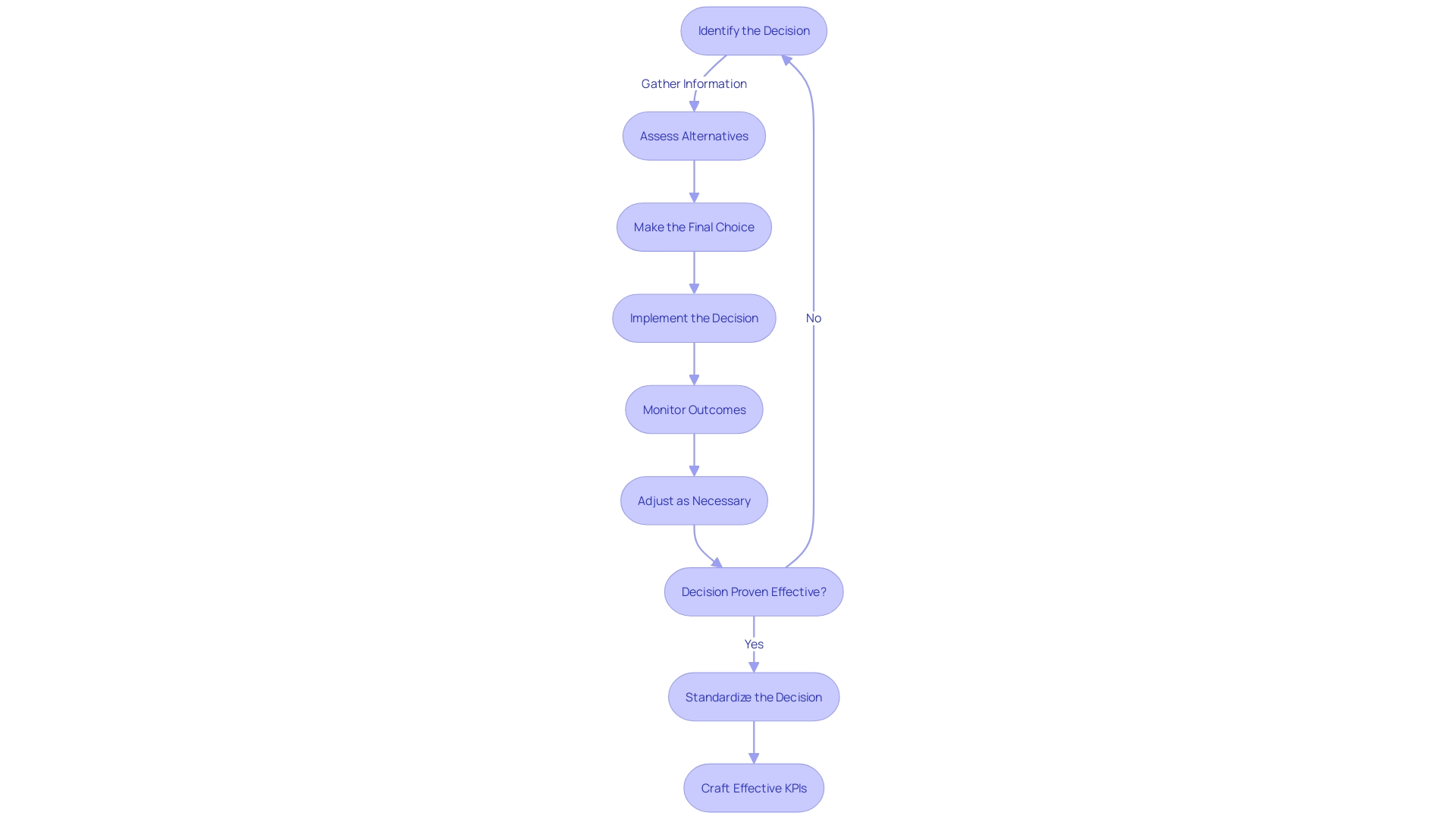
Iterative Improvement and Continuous Monitoring
-
Promoting a Learning Environment: To achieve excellence in practices, it's crucial to cultivate a culture that values learning and experimentation. This means encouraging teams to routinely evaluate their methods and pinpoint areas ripe for enhancement. For example, TBC Bank's mission to ease its customers' lives required a shift towards improving time-to-market, which was accomplished by fostering a culture that prioritizes continuous learning and agile responses to change.
-
Data-Driven Performance Monitoring: The heart of the practice is informed by continuous monitoring and the judicious use of data to steer improvements. Consistent measurement of performance outcomes can illuminate the path forward. Bosch, with its commitment to sustainability, has built a lean, evolutionary data platform, showcasing how monitoring can lead to efficient and green energy solutions, reflecting the power of data in driving meaningful change.
-
Feedback Integration: In the practice of continuous integration and delivery, feedback loops play a critical role. They must be robust enough to capture insights from end-users, developers, and operations teams alike. Microsoft's Radius project demonstrates the potential of utilizing such feedback in conjunction with modern tools like Terraform or Bicep, and an Application Graph, to automate and enhance infrastructure deployment while simplifying complex cloud applications.
-
Iterative Process Evolution: The adoption of a fail-fast mindset and the encouragement of process experimentation are key to DevOps success. This method is backed by the fact that almost 70% of companies acknowledge technical debt as a significant barrier to innovation. By promoting an environment where failure is seen as a learning opportunity, organizations can improve their competitive edge in a market where agility is increasingly synonymous with survival.
Embracing these principles of DevOps transformation ensures a dynamic and responsive approach to technology, which is vital in a landscape where technical debt management and the drive for faster, higher-quality software delivery are at the forefront of business success.
Conclusion
In conclusion, implementing DevOps requires a comprehensive and strategic approach. It begins with assessing the current state and defining objectives, taking into account the unique needs of the organization. Formulating a DevOps strategy involves adopting automation, continuous integration, and fostering collaboration.
Infrastructure as Code (IaC) plays a crucial role in modernizing infrastructure and ensuring scalability and agility.
Optimizing feedback loops and evolving culture and organization are essential for fostering collaboration and continuous improvement. Selecting and integrating the right tools is crucial for streamlining processes and improving efficiency. Investing in training and development is important for equipping the team with the necessary skills for a successful DevOps transformation.
Piloting and scaling DevOps practices involve identifying pilot projects, establishing key performance indicators (KPIs), and sharing knowledge across teams. Defining KPIs that align with business objectives and continuously monitoring progress is vital for tracking the impact of DevOps initiatives. Iterative improvement and continuous monitoring, along with fostering a learning culture, data-driven performance monitoring, and feedback integration, ensure a dynamic and responsive approach to technology.
Overall, organizations that embrace DevOps and follow these steps can navigate the complexities of digital transformation, drive innovation, and maintain a competitive edge in the rapidly evolving technological landscape.




